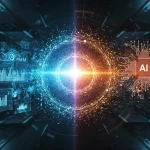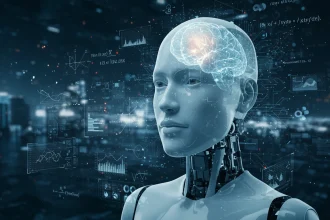Artificial Intelligence (AI) has emerged as a rapidly evolving field of technological development, possessing the potential to reshape countless aspects of daily life and the global economy. Indeed, the increasing integration of Artificial Intelligence into daily routines and work environments is becoming ever more evident, manifesting through technologies such as voice assistants, navigation applications, and chatbots. According to a 2018 McKinsey Global Institute report, it was anticipated that Artificial Intelligence could contribute a potential $13 trillion to the global economy by 2030. More recently, in 2023, McKinsey also found that a significant percentage of companies were already experimenting with and regularly using Generative AI.
Consequently, this rapid adoption suggests an acceleration in the impact of Artificial Intelligence, potentially leading to a faster realization of the estimated economic benefits and requiring swifter adaptation by companies and individuals. Furthermore, the transition of Artificial Intelligence from a futuristic concept to a practical tool, exemplified by the launch of ChatGPT in 2020, underscores the growing tangibility and accessibility of Artificial Intelligence to the general public and its potential for widespread application across various domains.
Key Trends and Predictions for the Future of Artificial Intelligence
Several important trends and predictions are shaping the future of Artificial Intelligence.
Firstly, the democratization of data and mass adoption are making Artificial Intelligence more accessible to businesses of all sizes. This movement is driven by the increasing availability of no-code and low-code tools. Indeed, these platforms allow teams without advanced technical skills to create customized solutions. Gartner, for example, estimates that by 2026, more than 80% of software vendors will integrate generative Artificial Intelligence into their products. Additionally, 70% of new applications will be developed with no-code or low-code tools. Undoubtedly, this accessibility could lead to an exponential increase in Artificial Intelligence applications across various sectors. Individuals and teams without traditional programming skills can now create custom AI solutions. This fosters innovation. It addresses niche problems efficiently.
Multimodal generative Artificial Intelligence
Represents another significant trend. Its models are capable of understanding and processing different forms of communication, such as text, images, and audio, and generating results in various formats. Furthermore, great promise lies in the future of autonomous Artificial Intelligence, capable of performing complex tasks with minimal human intervention. The development of autonomous multimodal Artificial Intelligence systems suggests a future where AI can handle more complex and nuanced tasks. This could lead to significant advancements in areas like robotics, customer service, and creative industries. However, this also raises questions about the level of human oversight and control necessary.
Concurrently, the coexistence of human collaborators and Artificial Intelligence agents is becoming a reality. In it, AI agents take on the role of team “members,” performing operational tasks and freeing up humans for strategic activities. Certainly, this collaboration can enhance productivity. It also reduces the workload of human employees. It creates new opportunities for scaling operations. The integration of Artificial Intelligence agents into human teams signifies a shift towards a hybrid workforce. In it, humans and Artificial Intelligence collaborate closely, requiring a reassessment of team structures, workflows, and the skills needed for effective human-AI collaboration.
Technological sustainability
Is another relevant point. The increasing use of Artificial Intelligence also raises concerns about technological sustainability. There is a growing focus on AI’s energy consumption and the construction of energy-efficient data centers. The increasing energy demands of Artificial Intelligence, particularly from large language models, highlight the need for innovations in energy-efficient computing and sustainable AI practices. Consequently, this could drive research into new hardware architectures, optimized algorithms, and the use of renewable energy sources for Artificial Intelligence infrastructure.
Moreover, Artificial Intelligence is also being used in real-time strategic decisions. It analyzes dynamic data and responds immediately to changes in the market or customer behavior. This capability provides a significant competitive advantage. Especially in fast-paced environments. It allows for quick adjustments and personalized experiences. The ability of Artificial Intelligence to process vast amounts of data and make strategic decisions in real-time can lead to more agile and responsive businesses. However, this also raises questions about the potential for algorithmic bias to influence these decisions and the need for robust monitoring and oversight.
The BYOAI (Bring Your Own AI)
Approach allows different areas of a company to use off-the-shelf AIs to solve specific problems. However, implementing BYOAI requires strict governance and a security strategy. The goal is to ensure responsible use. Avoid risks of data leakage and loss of control over critical processes. The BYOAI trend suggests a shift towards a more decentralized approach to Artificial Intelligence adoption within organizations. Therefore, this requires a change in IT strategy to enable and govern the use of external AI tools, rather than solely relying on in-house development. Robust governance frameworks are essential to manage risks and ensure data security and compliance.
Quantum computing, in turn, represents another trend with the potential to solve complex problems in cybersecurity and scientific simulations. However, quantum computing poses an imminent risk to digital security, as it can break all currently used forms of asymmetric encryption. This necessitates the adoption of new solutions, such as post-quantum cryptography. The emergence of quantum computing presents both opportunities and threats to the field of Artificial Intelligence. While it may enable breakthroughs in solving complex problems for AI, it also poses a significant risk to current cybersecurity infrastructure, requiring proactive measures like the development and adoption of post-quantum cryptography.
The concept of “harvest now, decrypt later”
Highlights the concern that hackers are already storing encrypted data to decrypt in the future with quantum technologies. Therefore, it is crucial to conduct a comprehensive audit of cryptography use. One must also develop an agile approach to quickly update systems as these threats materialize. The “harvest now, decrypt later” threat underscores the long-term security implications of quantum computing and the need for organizations to adopt a proactive approach to data protection by transitioning to post-quantum cryptographic methods.
Finally, AI ethics and governance will be a growing priority, focusing on transparency and ethical practices to prevent misinformation and biases. More than 90% of leaders are not ready to implement Artificial Intelligence effectively, and responsibility for governance is diffuse. In light of this, a unified framework is needed that incorporates responsible governance across all disciplines, from data and security to business processes and legal risks. The recognized unpreparedness among leaders for effective Artificial Intelligence implementation highlights a critical need for education, training, and the development of clear governance frameworks to ensure responsible and beneficial adoption of Artificial Intelligence within organizations.
Artificial Intelligence is also transforming education and healthcare, offering adaptive learning and personalized treatments. These trends represent strategic opportunities for companies looking to lead in the future. The application of Artificial Intelligence for personalization in education and healthcare suggests a future where services are tailored to individual needs. This could lead to better learning outcomes and more effective medical treatments. However, this also raises questions about data privacy. And the potential to exacerbate existing inequalities if access to these personalized solutions is not equitable.
Gartner Predictions for AI in 2025
| Prediction | Description |
|---|---|
| Data Democratization & Mass Adoption | AI becomes more accessible due to no-code and low-code tools. |
| Multimodal Generative AI | AI models process different forms of communication and generate diverse outputs. |
| Coexistence of Human Collaborators & AI Agents | AI agents integrate into teams, freeing humans for strategic tasks. |
| Technological Sustainability | Growing concern about AI’s energy consumption and focus on efficient data centers. |
| AI in Real-Time Strategic Decisions | AI analyzes dynamic data and responds to market changes in real-time. |
| BYOAI (Bring Your Own AI) | Different departments use off-the-shelf AIs, requiring strict governance. |
| Quantum Computing & AI | Integration with quantum computing to solve complex problems, but with security risks. |
| Post-Quantum Cryptography & Data Protection | Need to protect data against future quantum threats. |
| AI Ethics & Governance | Priority on AI regulation, transparency, and ethical practices. |
| Personalization at Scale in Education & Health | AI offers adaptive learning and personalized treatments. |
The Impact of Artificial Intelligence on the Job Market
Artificial Intelligence is causing significant disruption and transforming the job market. One of the main ways Artificial Intelligence impacts employment is through the automation of tasks and processes.
Artificial Intelligence excels at tasks involving pattern repetition. For example, sorting documents and information, text production, data reading, inventory control, and logistics. Solutions like Gupy Admissão use Artificial Intelligence to automate document validation, reducing hiring time by half. Consequently, the automation of routine tasks by Artificial Intelligence could lead to significant productivity gains for companies. But it also requires a focus on reskilling and upskilling the workforce. To adapt to new roles and responsibilities that demand uniquely human skills.
For low-skill jobs
There is a risk due to AI-driven automation. Especially in sectors like industrial production, transportation, and basic services. This underscores the importance of public policies and business strategies for worker reskilling. The potential displacement of low-skill jobs due to AI automation could exacerbate existing social and economic inequalities. Therefore, this highlights the importance of proactive government and business initiatives to provide training and support for affected workers, ensuring a just transition in the AI era.
However, Artificial Intelligence is also generating significant productivity and economic gains. A 2024 PwC study, for example, shows a 4.8-fold increase in productivity in sectors using Artificial Intelligence. And a 2023 BCG study indicates that Generative AI has the potential to generate a productivity increase of about 30% across the entire HR journey in the short term. The significant productivity gains enabled by Artificial Intelligence suggest potential for economic growth and greater efficiency across various sectors. However, it’s important to consider how these gains are distributed and whether they lead to broader societal benefits.
New roles and new skills
Furthermore, Artificial Intelligence is creating new roles and requiring new skills. An Accenture report, “Future Skills Pilot,” predicts that 97 million new roles could emerge by 2025 due to the human-technology relationship. Gupy’s 2024 Employability Report, similarly, revealed a 306% increase in companies seeking professionals with Artificial Intelligence knowledge. Particularly for technical, operator, and developer roles. The emergence of new roles related to AI development, implementation, and maintenance indicates a shift in the labor market towards more technically skilled positions. This highlights the importance of investing in STEM education and training programs. To prepare the future workforce for these in-demand roles.
The new skills required for the AI era include both technological skills, such as programming and data science, and analytical and emotional skills, such as complex problem-solving and adaptability. Roles like machine learning specialists, data analysts, AI engineers, and AI ethics consultants are emerging. The increasing importance of “soft skills” like empathy, communication, collaboration, and creativity, alongside technical skills, suggests a future where human interaction and uniquely human capabilities will be highly valued in the workplace, even as AI takes on more routine tasks.
Humans and Artificial Intelligence together
Hybrid roles, where humans and Artificial Intelligence work together, are on the rise. As are remote and flexible work models facilitated by AI-based technologies. The rise of hybrid roles and remote work facilitated by AI could lead to a more flexible and distributed workforce, potentially increasing access to talent and improving employees’ work-life balance. However, it also presents challenges in terms of team cohesion, communication, and ensuring equitable access to technology and resources.
The prediction of new job creation by Artificial Intelligence surpasses the displacement estimate. This suggests a net positive impact on employment in the long term. However, the transition period will require significant investment in reskilling and upskilling initiatives. To ensure workers can adapt to the changing demands of the labor market. The TI Inside article highlights a paradox: as technology advances, the value attributed to uniquely human skills like empathy, personalization, and creativity increases. This suggests a shift in the labor market where roles requiring these skills will become more important and potentially more valued.
Impact of AI on the Job Market: Predictions
| Source | Prediction | Deadline |
|---|---|---|
| World Economic Forum | Creation of 97 million new roles | 2025 |
| World Economic Forum | Displacement of 85 million traditional roles | 2025 |
| PwC | Creation of 2.7 million jobs in the UK | 2037 |
| BCG | 30% productivity increase in HR with Generative AI | Short term |
Applications of Artificial Intelligence in Various Sectors
Artificial Intelligence is poised to revolutionize key sectors such as healthcare, education, and transportation. In healthcare, for example, Artificial Intelligence drives advancements in diagnostics. Its ability to analyze medical images like X-rays and MRIs with greater accuracy and speed potentially reduces human errors. The application of AI in medical imaging not only improves diagnostic accuracy but can also alleviate the workload of radiologists and other healthcare professionals. It allows them to focus on more complex cases and patient interaction.
Personalized medicine
Is also a potential of The Future of Artificial Intelligence, with treatment plans based on the analysis of genetic and historical data. Indeed, AI-driven personalized medicine has the potential to revolutionize healthcare. It tailors treatments to each patient’s unique biological and medical history. This could lead to more effective therapies and better outcomes. But it also raises ethical considerations around data privacy and access to such advanced treatments.
Furthermore, Artificial Intelligence assists in surgical procedures through robotics, potentially minimizing risks. AI-powered surgical robots can perform complex procedures with greater precision and stability than human surgeons. Potentially leading to less invasiveness, faster recovery times, and better patient outcomes. However, this also raises questions about the role of human surgeons and the training required to operate these advanced systems.
For prevention
AI is also used to monitor patients and predict health problems before they worsen. Continuous patient monitoring through AI-powered devices and analytics can enable early detection of health issues. It allows for timely interventions. Potentially prevents serious complications or hospitalizations.
Moreover, Artificial Intelligence has the potential to optimize administrative tasks and reduce costs in healthcare. Artificial Intelligence can automate many administrative tasks in healthcare. Such as appointment scheduling, record keeping, and insurance claim processing. This frees up healthcare professionals to dedicate more time to direct patient care and potentially reduces operational costs for healthcare providers.
Finally, Artificial Intelligence facilitates drug discovery and development by analyzing large volumes of data. AI’s ability to analyze vast datasets of biological and chemical information can significantly accelerate the drug discovery and development process. Potentially leading to faster breakthroughs in treating diseases. This could also reduce the cost and time associated with bringing new drugs to market.
In education
Artificial Intelligence has the potential to personalize learning experiences. It adapts content and pace to the individual needs of each student. AI-powered personalized learning platforms can tailor the curriculum and learning pace to individual student needs and learning styles. Potentially leading to better understanding, engagement, and academic outcomes. However, ensuring equitable access to these technologies and addressing potential biases in algorithms are crucial considerations.
Artificial Intelligence can also help eliminate cultural and linguistic barriers through real-time translation and personalized explanations. AI-powered translation tools and personalized explanations can break down cultural and linguistic barriers in education. Making learning more accessible to a diverse student population. This can promote greater inclusion and understanding in educational contexts.
Making a difference
Initiatives like Musa’s use AI-based microlearning via WhatsApp to democratize education. Making it accessible to those traditionally marginalized by conventional systems. Leveraging widely accessible platforms like WhatsApp for AI-powered microlearning can democratize education. It reaches individuals in underserved communities. It provides them with flexible and engaging learning opportunities. This approach has the potential to significantly expand access to education and improve learning outcomes for marginalized populations.
The Hunu app, by Kraft Education, illustrates AI’s potential to address specific educational needs at scale. It assists children with learning difficulties, such as ADHD, through personalized content and contextual interventions. AI-powered tools can be developed to address the specific learning needs of students with disabilities or learning difficulties. Providing personalized content and interventions to support their educational journey. This can lead to more inclusive and effective learning experiences for all students.
MakerDost, in India, integrates AI-based hands-on learning environments. It equips students with essential skills for the job market. It prepares young people for the challenges of a constantly transforming professional world. Integrating AI into hands-on learning environments can provide students with practical experience in using AI tools and technologies relevant to the job market. Better preparing them for future careers in an increasingly AI-driven world. This can bridge the gap between academic learning and the practical skills required by employers.
A tool
Finally, Artificial Intelligence does not replace teachers but transforms their role. By using AI to provide adaptive learning resources, educators can focus more on building human connections and guiding students, acting as mentors and facilitators. With AI handling some aspects of instruction and providing adaptive learning resources, the role of educators can evolve towards more personalized guidance and mentoring. Fostering greater student engagement and critical thinking skills. This shift requires teachers to develop new skills in using AI tools and facilitating AI-enhanced learning experiences.
In transportation
Artificial Intelligence improves road safety and operational efficiency in fleet management. AI-powered telematics solutions can provide fleet managers with real-time information on driver behavior and vehicle performance. They allow for proactive interventions to improve safety, reduce fuel consumption, and optimize routes. This can lead to significant cost savings and improved operational efficiency for transportation companies. These solutions enable continuous monitoring of driver behavior, detection of risk events, and real-time alerts.
AI-powered systems that monitor driver behavior in real-time and provide immediate feedback can be highly effective in reducing risky driving habits and preventing accidents. This technology has the potential to significantly improve road safety. Both for fleet operators and the general public. As the use of real-time vehicle data increases, data privacy in fleet management becomes crucial. The collection and analysis of real-time vehicle and driver data raise significant privacy concerns. It is crucial for transportation companies and technology providers to implement robust data protection measures and adhere to ethical guidelines. To ensure this data is handled responsibly and user privacy is respected.
Ethical and Social Implications of Artificial Intelligence
The ethical and social implications of Artificial Intelligence are critical considerations that need to be addressed. Algorithmic bias, for example, is a significant concern. It occurs when AI systems are trained on biased datasets or when the underlying logic of their decision-making processes is unfair or discriminatory. This can lead to the perpetuation and even amplification of existing social biases, rather than promoting fairness and equal treatment. Algorithmic bias poses a significant threat to fairness and equity in AI applications, potentially leading to discriminatory outcomes in areas like hiring, lending, and even criminal justice. Addressing this requires careful attention to the data used to train AI models, as well as the design and evaluation of the algorithms themselves.
The vast amount of data used to train AI systems, including sensitive personal information, raises concerns about privacy and security. AI’s reliance on large datasets, often containing sensitive personal information, raises significant privacy and security concerns. Therefore, robust data protection measures, including anonymization and encryption techniques, are essential to prevent data breaches and ensure compliance with privacy regulations.
The complexity of AI systems, on the other hand, makes it difficult to assign responsibility when they make incorrect or harmful decisions. The increasing autonomy of AI systems raises complex questions about accountability when these systems make mistakes or cause harm. Determining who is responsible – the developers, the users, or the AI itself – is a significant challenge that needs to be addressed through clear legal and ethical frameworks.
False information and manipulation
Additionally, Artificial Intelligence can be used to disseminate false information and manipulate opinions. Particularly through recommendation algorithms on social media and the creation of realistic fake content (deepfakes). AI’s ability to generate realistic fake content (deepfakes) and manipulate information dissemination through recommendation algorithms poses a significant threat to information integrity and democratic processes. Addressing this requires a combination of technological solutions for detection and mitigation, as well as media literacy initiatives to help individuals critically evaluate online content.
To address these ethical challenges, it is crucial to adopt guidelines. These serve to design, develop, and implement AI systems ethically. These guidelines include constant evaluations and adjustments, human-AI collaboration, equity and fairness, protection of data privacy and security, accountability, safety, and transparency. The ethical challenges posed by AI require a proactive and ongoing effort to evaluate and adjust AI systems, ensure human oversight, promote fairness and transparency, and prioritize safety and privacy. This demands a collaborative approach involving developers, policymakers, and the public to establish and enforce ethical guidelines for AI development and deployment.
The conflict between algorithmic bias and fundamental liberal values such as individual freedom, responsibility, the rule of law, private property, and the market economy, as highlighted in the Instituto Liberal article, underscores the fundamental importance of addressing ethical considerations in AI development and deployment to safeguard democratic principles and individual rights.
Preparing for the Future of Artificial Intelligence
To prepare for the future of Artificial Intelligence, individuals, businesses, and policymakers must take proactive steps.
Individuals should emphasize the need for continuous learning and reskilling. To adapt to the changing job market. It is crucial to develop uniquely human skills like creativity, critical thinking, and emotional intelligence. Individuals should also become more AI-aware and understand its implications in their daily lives.
Businesses, in turn, should invest in training and development for employees to work alongside AI. It is advisable for companies to identify high-impact applications of AI and develop strategies for their implementation. It is fundamental to establish robust governance frameworks for AI adoption, addressing ethical considerations, data privacy, and security. Businesses are encouraged to foster a culture of innovation and adaptability to leverage AI’s potential.
Policymakers should underscore the need for clear regulations and ethical guidelines for AI development and deployment. Investment in education and training programs is recommended to prepare the workforce for the future of work in the AI era. It is important to address potential social and economic inequalities that may arise from widespread AI adoption. International collaboration should be promoted to establish global standards and best practices for AI governance.
Conclusion: The Future of Artificial Intelligence Shaping the World
In summary, Artificial Intelligence represents a transformative force with the potential to reshape our world in profound ways. Its benefits span various sectors, including economic growth, improved healthcare, enhanced education, and increased transportation efficiency. However, to fully harness AI’s potential, it is imperative to address the ethical and social challenges associated with its implementation. By focusing on mitigating algorithmic bias, ensuring data privacy and security, and establishing clear governance frameworks, we can guide AI’s evolution in a responsible and beneficial manner. The future of Artificial Intelligence promises further advancements and innovations. Our ability to prepare for these changes and address them ethically will shape its lasting impact on society.
Did you like the article The Future of Artificial Intelligence and Its Impacts on the World? Check out more here.








